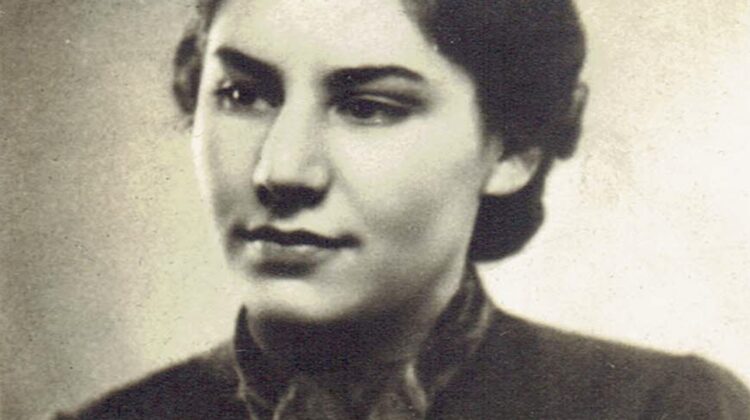

Though I am not as good as I’d like to be at keeping up with this blog—and not as good as Google would like me to be, according to my rankings–many people have nevertheless managed to find my posts over the years. Most recently, I heard from my cousin Rena, whom I’d been trying to locate for years. Those marital name changes wreak havoc on genealogy.
She commented:
I have been tracking information on the Kornhmehl family and found your article about Curt Allina who was my cousin. I can fill you in on family information that you indicated you wondered about. I am Helena Kornmehl Neugasser’s granddaughter.
I remember your parents: Paul and Rita and that they had 2 daughters.
I was thrilled to hear from Rena and we began a regular phone correspondence, which we think is riveting but which people who are not related to us might not find especially interesting.
And then Rena sent family pictures, which changes everything, because everyone loves old photographs.
I am therefore taking this opportunity to step back and offer an illustrated review of how various people I’ve written about are related to me and to each other.
The Tarnow Connection
Many of my maternal ancestors lived in a Polish shtetl called Tarnow;* their residence there dates back to at least to the 18th century but, to simplify things, I am going to start this story with the generation of of my great grandfather, Chaim Heinrich Kornmehl. As the family tree shows, the birthdates of the nine siblings who made it to adulthood range from the 1820s to the 1860s.
These nine siblings, in turn, produced 57 grandchildren. Eight of them, including my grandmother Ernestine Kornmehl Rosenbaum, were the offspring of Chaim Heinrich and Chaya Henriette Scheindle Kornmehl.

One of Chaim’s brothers, Elias Kornmehl, is the patriarch of the Schmerling family, about whom I have written a great deal. Here he is with his wife, Doba.
Among the reasons that I have written so much about the Schmerling family is that one of Elias and Doba’s children, David Schmerling, married his first cousin, Mitzi, one of my grandmother’s sisters and thus my great aunt.
Kornmehls, Allinas, and Neugassers
But this story focuses on the family of another of my great grandfather’s siblings, Aron Juda Kornmehl (1852-?). The photograph below, taken ca. 1890, shows Aron with his wife, Regina/Rivka, and their daughter Helena, born 1887. Helena is the middle child of three—her brother Siegmund (b. 1875) is older, her sister Mina (b. 1894) is younger. Because of the span of the siblings’ ages, it’s likely that Helena was enjoying a rare period of having her parents all to herself.
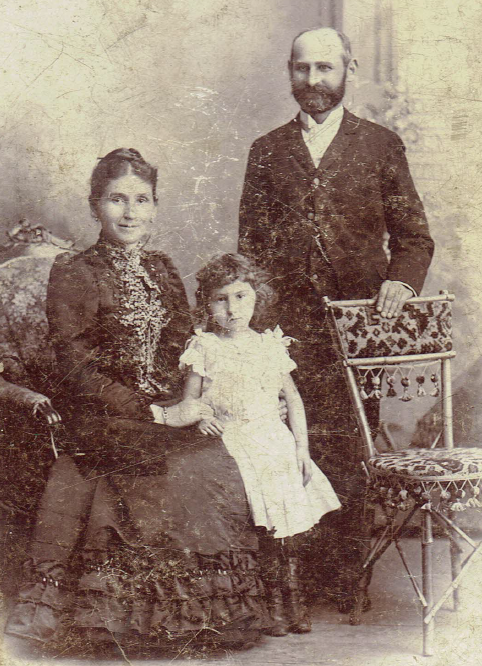
The Oldest Child: (The Other) Siegmund Kornmehl
I have also written a good deal about the oldest child of Aron and Rivka Kornmehl, because, like David Schmerling, he married one of my great-grandfather’s offspring, in this case my great aunt Anna Kornmehl. I began calling him the Other Siegmund Kornmehl (OSK) here to distinguish him from the Siegmund Kornmehl who had a butcher shop in Sigmund Freud’s building. (Yes, this is a Tale of Three Sigmunds.) This does not do OSK’s own achievements justice—he had a very successful business, the Cafe Viktoria—but I knew virtually nothing about him when I started my research into the man for whom this blog is named.
I continue to be more amused than I probably should be by the fact that my great aunt Anna married a man with the same name as one of her brothers. It seems, well, Freudian.
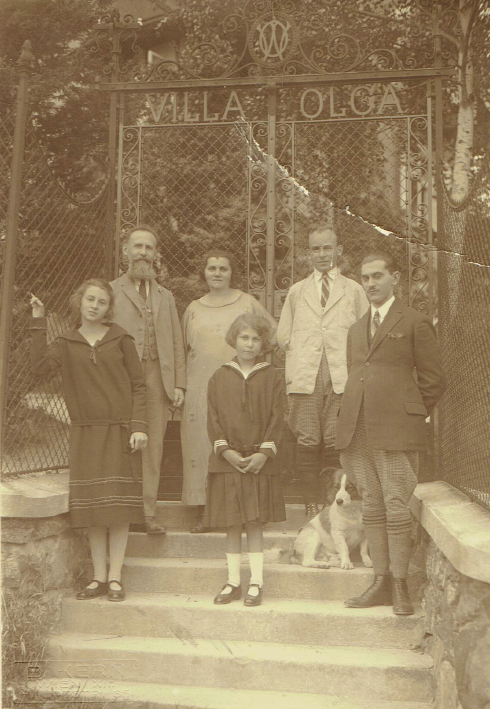
Her spouse’s name and close kinship to her notwithstanding, Anna seems to have married well. I don’t know anything about Villa Olga, shown above, other than it belonged to OSK’s family and was an object of envy. Nor was I able to glean much information about the very cute dog in the picture, except that Rena’s mother was terrified of it. Fellow genealogy blogger and dog lover Vera Marie Badertscher suggested that the dog’s name was, of course, Olga.
It took me a minute.
Before her parents moved from Tarnow to Vienna, Helena lived with her older brother Siegmund and his wife in Vienna for a few years when she was a child.
Siegmund died before the Nazi takeover of Austria, in February 1938, but Anna, Grete, and Alfons were murdered in concentration camps. Hetty and Egon made their way to America, and lived for a time in Brooklyn. More on that in a minute.
The Youngest Child: Mina Kornmehl Allina
Aaron Juda and Rivka Kornmehl’s third child, Mina, married Erwin Allina, who was from the Czech Republic. I have also written a great deal about this family, in part because one of Mina and Ervin’s children has an interesting claim to fame; see Who Put the Heads On Pez? My Cousin Curt!
The story of Mina’s family’s is perhaps the saddest of all. Erwin went to America to find work in the mid-1920s and Mina stayed behind in Vienna, where she and her four children–Gertrude (b. 1918), Hans ( b. 1919), Curt (b. 1922) and Erika (b. 1924)–lived for many years in #18 Bergasse, a building owned by Siegmund Kornmehl the butcher. Mina never made it to America, and neither did three of the four children: After Curt was liberated from Auschwitz, he went in search of his family. He discovered his mother and sister Erika had died in concentration camps and that his brother had been shot by the Nazis but learned that his sister Gertrude (pictured next to the title of this post) had survived. When Curt went to Bergen-Belsen, her last known location, to be reunited with her, he found out that she had died of typhus—after liberation but less than a week before he could reach her.
Curt remained bitter and angry at his father for abandoning the family for the rest of his life.
The Middle Child: Helena Kornmehl Neugasser
It was my post about Curt, in which I describe his father as a cad, that elicited the comment from my cousin Rena that started our correspondence.
She wrote:
People did stay in touch by mail in the 1930’s. Ervin didn’t just disappear. He went to work on ships crossing to America. He made several crossings. When he came to New York in about 1938, the family told him to stay. That he shouldn’t return because of the Anschluss. So, he did. He lived with our family until the early 1950’s when he remarried. They also made strong attempts to get the rest of his family out of Europe but were unsuccessful.
There is also a family rumor that Erwin returned to Vienna from one of his trips to discover that Mina had given birth to Erika, a child that couldn’t have been his.
So…there are always at least a dozen sides to every story.
To get back to Helena. She married a tailor named Isaac Neugasser and they had two children, Martha and Walter. Here is a picture of Helena with them, ca.1923-1924
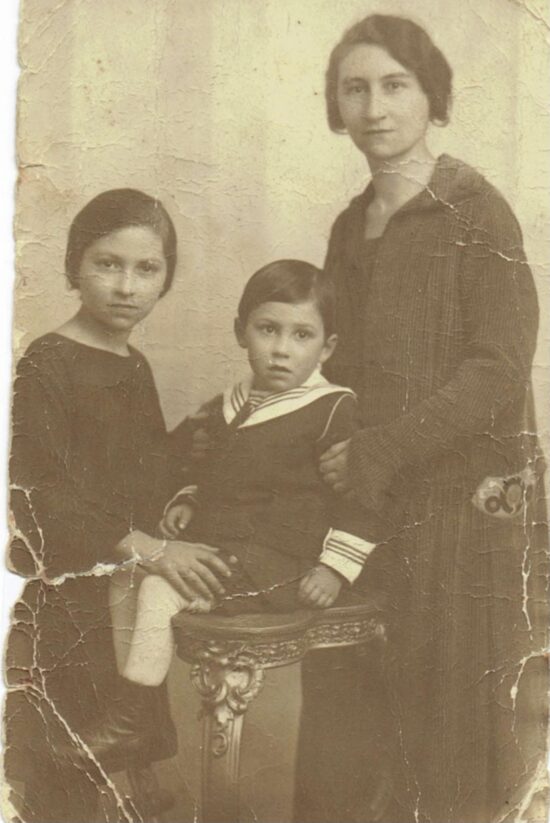
Perhaps Isaac Neugasser is absent from this picture because he had already emigrated to the U.S.; he left in1923. He was joined, six years later, by his wife and children. Thus, unlike so many others in my family, including Helena’s two siblings, theirs was not a tragic Holocaust story.
Initially the family lived in the Bronx, but they later moved to Brooklyn, where Martha Neugasser married Aaron Weiss in 1935. They had two children, Marvin and Rena–she who I had been searching for. Early on, I wrote a blog post about these connections: Rewriting My Childhood: A Tale of Mystery Relatives.
I learned a few more things about the family since I wrote that post, including the fact that Helena’s brother-in-law Erwin Allina lived with the Neugasser family for many years.
In further defense of Erwin and the rest of her own family Rena wrote:
They tracked the refugee ships to ensure that if there were relatives on them, they were welcomed.
Both Hetty Kornmehl Sternberg and her family and Egon Kornmehl and his wife were also shoe horned into the family apartment in Brighton Beach. Until the mid-1960’s when my grandmother died, there were always cousins over for coffee and her fabulous baking.
My parents were among those cousins. I asked Rena what she recalled about them and she said not much; she recollects them as being rather quiet—but, as she pointed out, she was young and didn’t pay much attention to the adults.
My vague memories of these occasional visits include wandering off on the block where they lived and being unable to find my way back to their apartment building, which is very typical of me, but I don’t recall the baked goods, which isn’t.
The Kornmehl-Rosenbaum-Jarolims
I always have mixed feelings when I find out more about my parents’ families. I am naturally interested in learning as much as possible about my relatives but these stories always show my mother and father on the periphery of family circles—if present at all. In this case, particularly, I’m sad that my parents were not more memorable to Rena, presumably because our visits were so rare. My mother was socially awkward so I could see her being described as quiet but my father was generally a friendly guy. If we had visited often enough through the years, I imagine he would have made more of an impression.
Just as visiting the Neugassers in Brighton Beach was intermittent, so were interactions with Hetty Kornmehl Sternberg and her husband Otto. I recall my mother going to see them on the Upper West Side when I got older, but we never ate dinner at their house or saw them on a regular basis.
And don’t even get me started about the fact that we had a great uncle and close cousins in Queens that I never met.
Perhaps the fact that best sums up our family’s isolation, not to mention our inner family rifts: I was the only relative at my mother’s New York funeral.
But…another reason I’ve written a lot about the Schmerling family is that my mother was very close to her cousins Stella, Mimi, and Ditte, and to her aunt Mitzi. I like to think that if we’d lived in London or they in New York we would have seen them often. So I’ll leave you with one of the pictures on which I base that hypothesis, one that includes a dog whose name (if not gender) I do know.


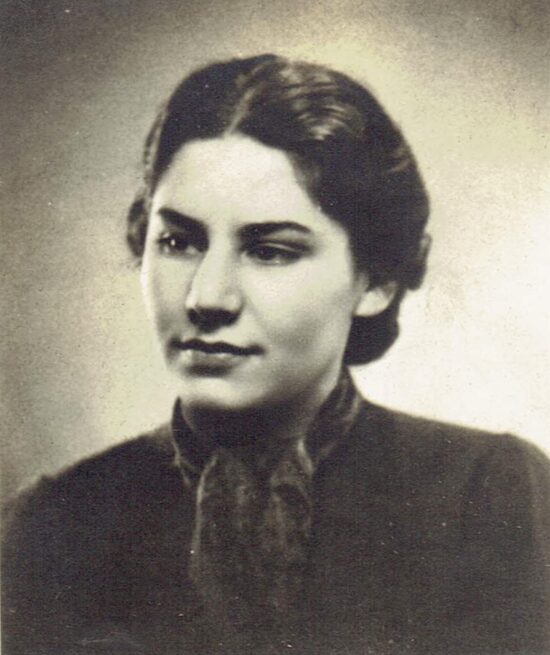
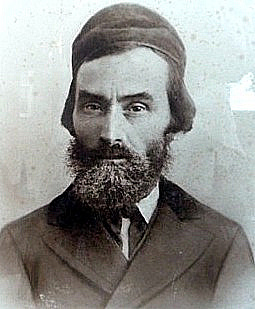
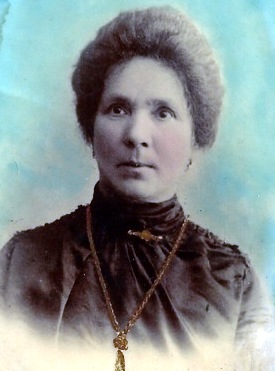
Very interesting. Thank you Edie!
Some day we’ll find the family connection, Miron!
Hello Edie– I’m Jo-Ann Sternberg– daughter of Henry Sternberg– granddaughter of Hettie Kornmehl and Dr Otto Sternberg! Let’s connect!
Thanks so much for contacting me! I am writing an email to you right now.